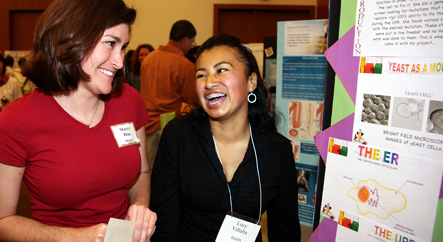
By Jennifer Charney
After only eight weeks this summer, a UCSF internship program inspired high school senior Lucy Villalta, who would be the first college student in her family, to consider pursuing a career as a scientist.
Villalta was among a group of 20 students in the Science and Health Education Partnership (SEP) High School Summer Internship Program, which marked its 2007 participants' research accomplishments with an Aug. 9 poster session and celebration in the Mission Bay Conference Center. The event drew more than 100 relatives, teachers, UCSF lab mentors and staff members.
The internship program, which began in 1989, provides rising seniors from San Francisco Unified School District (SFUSD) schools an intensive mentored research experience. While at UCSF, the students are immersed in a university environment and receive college counseling.
The program is one of the many efforts of SEP, a partnership between UCSF and SFUSD with the mission of bringing together scientists, health professionals and teachers to support high quality science education for all students attending kindergarten through twelfth grade.
Strengthening partnerships with local schools, community colleges and California State University campuses to enrich educational opportunities in these institutions, particularly for students from disadvantaged backgrounds, is a recommendation in the UCSF Strategic Plan. Unveiled in June, the comprehensive strategic plan charts the University's course as a global leader in health sciences over the next two decades. The plan, which includes a section on serving the community, is posted
here.
Making a Difference
The majority of the SEP summer interns do not have family members with college degrees, and many are immigrants or the children of immigrants. Almost all of the interns enter college, says SEP Co-Director Rebecca Smith. Based on these students' parental educational attainment, only 54 percent would have been expected to do so. Of those SEP interns, 73 percent majored in science, and 72 percent have entered or plan to enter graduate or professional schools, according to Smith.
Villalta, who attends John O'Connell High School of Technology, says she developed an interest in science while taking a biotechnology course last year. "Now science is my favorite subject. I want to be a veterinarian. I love animals," Villalta says, adding that she hopes to attend UC Davis in 2008. Villalta says she valued the internship because it exposed her to the realities of working in a lab.
As Villalta's volunteer internship mentor, Marcy Diaz, a UCSF PhD candidate in biochemistry, designed a project that would expose her eager protege to different lab techniques. Villalta used yeast cells to study the root of a gene mutation called rlg1-100. She explained her work to celebration attendees in a poster titled "Search for UPR Suppressors." The Unfolded Protein Response is a cellular process to ensure that newly made proteins are folded correctly.
 |
Mentor Marcy Diaz, a UCSF PhD candidate in biochemistry, left, talks with Lucy Villalta, who recently participated in the Science and Health Education Partnership High School Summer Internship Program. |
Stellar Luo was another beaming intern at the celebration. A senior at Thurgood Marshall Academic High School, Luo studied lipid metabolism to show how enzymes could be used for the treatment of type 2 diabetes and obesity. Her volunteer internship mentor, Carrie Grueter, is a postdoctoral fellow in physiology at the UCSF-affiliated Gladstone Institute of Cardiovascular Disease. Grueter designed Luo's project titled, "Why Are Dgat1 Knockout Mice Resistant to Diet-Induced Obesity and Type 2 Diabetes?"
"What's most rewarding is to see her excitement," says Grueter, referring to Luo. "It's also very rewarding to see how Stellar learns and understands."
Grueter says Luo "is a very impressive young lady," explaining that the Chinese teenager has been in the United States for only two years. In addition, she translates for her parents, who don't speak English and did not attend college.
Luo says she has always been interested in science. She valued her internship because it addressed her interest in the relationship of cells to the whole human body.
"The [internship] program is awesome! We not only work in the lab, but we work with an advisor," Luo says, referring to the program's intensive instruction in how to write personal statements for college applications.
Smith says Stellar Luo truly is stellar, as are the other interns. "In the program, their confidence level improves. And now they know what it's like to work in a lab and what it's like to be at a university."
Andrew Grillo-Hill, SEP academic coordinator, explains that in addition to the 180 hours students spend in the labs, the program includes extensive college counseling consisting of learning how to apply to college and for financial aid, support in writing their personal statement and a day trip to another college campus. This year students toured UC Davis and talked to past interns who are currently undergraduates there.
Each year, all SFUSD high school science teachers are invited to nominate students for the program. This year's 20 interns were selected from 130 nominated candidates and came from 15 different SFUSD high schools across the city. Grillo-Hill says criteria for acceptance include students' interest in learning and science and an explanation of how the program would make a critical difference in their lives. Grades are not considered.
The internship celebration was an exuberant end to another successful year, which is also the 20th anniversary of SEP.
Photos by Susan Merrell
Related Link:
Science and Health Education Partnership (SEP)

